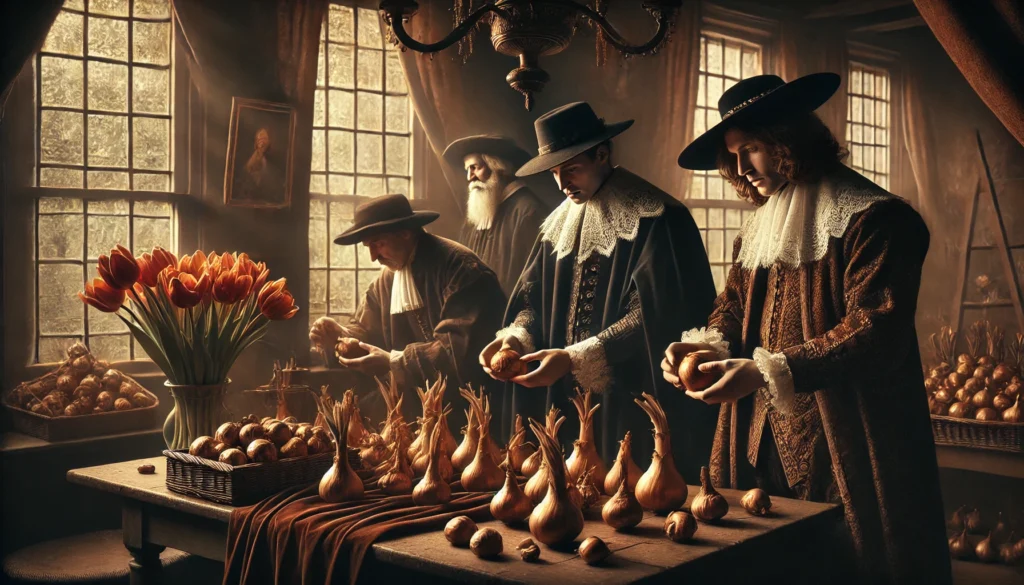Did You Know?
In 17th-century Netherlands, a single tulip bulb was worth as much as a luxurious house in Amsterdam—until it wasn’t. Welcome to the world of Tulip Mania (1637), often referred to as history’s first recorded speculative bubble.
Introduction
Imagine living in a time when flowers could determine your wealth and fortunes were made or lost over tulip bulbs. Sounds bizarre? That’s exactly what happened during the Dutch Golden Age, a period of economic prosperity in the Netherlands. Tulip Mania (1637) is an enthralling chapter in economic history, shedding light on the human penchant for speculation and greed. Let’s unravel this captivating story of how a simple flower wreaked havoc on an entire economy.
The Blooming Start: Why Tulips?
Tulips first arrived in the Netherlands from Turkey in the late 16th century, introduced by European botanists enamoured with their vibrant colours and unique shapes. These exotic flowers quickly became a status symbol among the wealthy, akin to owning a luxury car today. Rare varieties, like the flame-patterned Semper Augustus, were particularly prized, with their value skyrocketing as demand grew.
But how did tulips become a speculative commodity? The answer lies in a mix of scarcity and societal obsession. By the 1630s, tulips weren’t just flowers; they were investments. Traders began speculating on tulip prices, confident that they would keep climbing indefinitely.

The Craze: Tulip Contracts and Frenzied Trading
At the height of Tulip Mania, tulips weren’t even physically exchanged. Instead, buyers and sellers traded contracts akin to today’s futures markets. Wealthy merchants, farmers, and even middle-class citizens joined the frenzy, borrowing money or selling assets to purchase tulip bulbs.
For instance:
- A single bulb of the prized Semper Augustus sold for 10,000 guilders—equivalent to a year’s salary for a skilled artisan or the cost of a lavish canal-side mansion.
- Bakers, cobblers, and blacksmiths abandoned their trades, believing tulips were their ticket to riches.
The market became so overheated that a “paper bulb” (a contract for future delivery) could change hands dozens of times in a single day.
The Collapse: From Wealth to Woes
In February 1637, the bubble burst. The first signs of trouble appeared when buyers at a routine auction refused to pay astronomical prices. Panic ensued, and within weeks, tulip prices plummeted by over 90%.
People who had invested their life savings were left with worthless bulbs or unpaid contracts. Cities like Haarlem and Amsterdam, which had hosted the most active trading, witnessed widespread bankruptcies. The aftermath was sobering: trust in speculative markets eroded, and Dutch society reeled from the economic blow.
Lessons from Tulip Mania
Although the economic fallout of Tulip Mania wasn’t as devastating as modern financial crises, it left behind timeless lessons:
Greed Can Blind Logic: The irrational belief that prices will keep rising fueled the bubble. This behaviour echoes recent phenomena, such as the Dot-Com Bubble (the 1990s) and the cryptocurrency surges.
Market Oversight Matters: Unregulated speculation contributed to Tulip Mania’s chaos, a cautionary tale for today’s financial systems.
Speculation Isn’t Limited to Stocks: Tulips remind us that anything—flowers, real estate, or digital art (NFTs, non-fungible tokens)—can become a speculative asset.
Conclusion
Tulip Mania (1637) serves as a fascinating reminder of humanity’s susceptibility to hype, speculation, and herd mentality. It’s a tale that resonates even in today’s world, where market booms and busts are far too common. As we navigate the complexities of modern economies, let’s remember the humble tulip’s lesson: sometimes, the prettiest things can hide the sharpest thorns.
Author’s Note
Writing about Tulip Mania reminds me of the delicate balance between ambition and greed. Let’s learn from the past and shape a wiser future together.
G.C., Ecosociosphere contributor.
References and Further Reading





Comments
Thank you for writing this article. I appreciate the subject too. http://www.hairstylesvip.com
How can I find out more about it? http://www.hairstylesvip.com